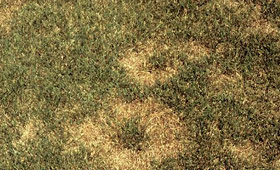Summer Patch, Magnaporthe poae

From Summer Patch, Penn State Center for Turfgrass Science.
IPM Steps to Reduce Summer Patch
1. Sample for Pest
Confirm the presence of summer patch before you treat.
Where to find it while inspecting: In mowed turfgrasses (Kentucky bluegrass and annual bluegrass) summer patch attacks roots and crowns and shows up as dead patches: small round or oval patches in orange-brown color. More likely on turf stressed by heavy traffic, poor air circulation and poor drainage.
2. Proper ID
Is it summer patch?
Size and Appearance: 2–3" circles up to 12", yellowish turning to straw-brown.
3. Learn the Pest Biology
What is the life cycle of summer patch?
Life Cycle: This fungus occurs in many soils and becomes active under favorable weather conditions—typically extended periods of temperatures over 82 degrees after extended leaf wetness.
Preferred Food Sources: Fungal diseases obtain nutrients by breaking down organic matter.
Preferred Habitat: Magnaporthe prefers bluegrass and attacks the crown and roots. It is naturally occurring in the soil.
4. Determine Threshold
How much summer patch is too much?
Threshold: Magnaporthe is likely to return with an increase each time conditions are favorable. If this disease is found on a prime turf field, you may wish to consult a certified pesticide applicator.
5. Choose Tactics
Creating a healthy soil condition and understanding turfgrass’s needs is the first step in reducing turf pests.
Best Management Practices: Promoting root health and reducing plant stress is the best way to reduce damage. Increased aeration and good drainage is important for root health. Raise mowing heights when possible. Reseed areas with resistant varieties of bluegrass. In isolated spots, you may consider removing turf and root zone and replacing. Do not fertilize turf in the summer.
Treatment Methods: Damage to high priority turf may need fungicide treatments—best done as a preventive application in areas that repeatedly have had damage. Aeration before, and irrigation before and after help move fungicide to the root area where it’s needed. Don’t apply unless soil temperature at 3" has reached 65 and stayed there.
6. Evaluate
Was the tactic successful? Record the date pests were first noted, and the tactic you used, and its success. Use one of our RECORD KEEPING tools.
For More Information:
Cornell Cooperative Extension Horticulture Diagnostic Laboratory: Summer Patch on Turfgrass
Remember:
When a pesticide application is necessary, all necessary and required precautions are taken to minimize risk to people and the environment and to minimize risk of pesticide resistance or pest resurgence. Pesticide use in your school may be prohibited or regulated by local policies or state and federal regulations. Risk reduction methods can include, but are not limited to, spot-treatment, the use of gel or paste bait formulations placed in inaccessible locations, injection into a crack or crevice, and other methods that reduce potential exposure.